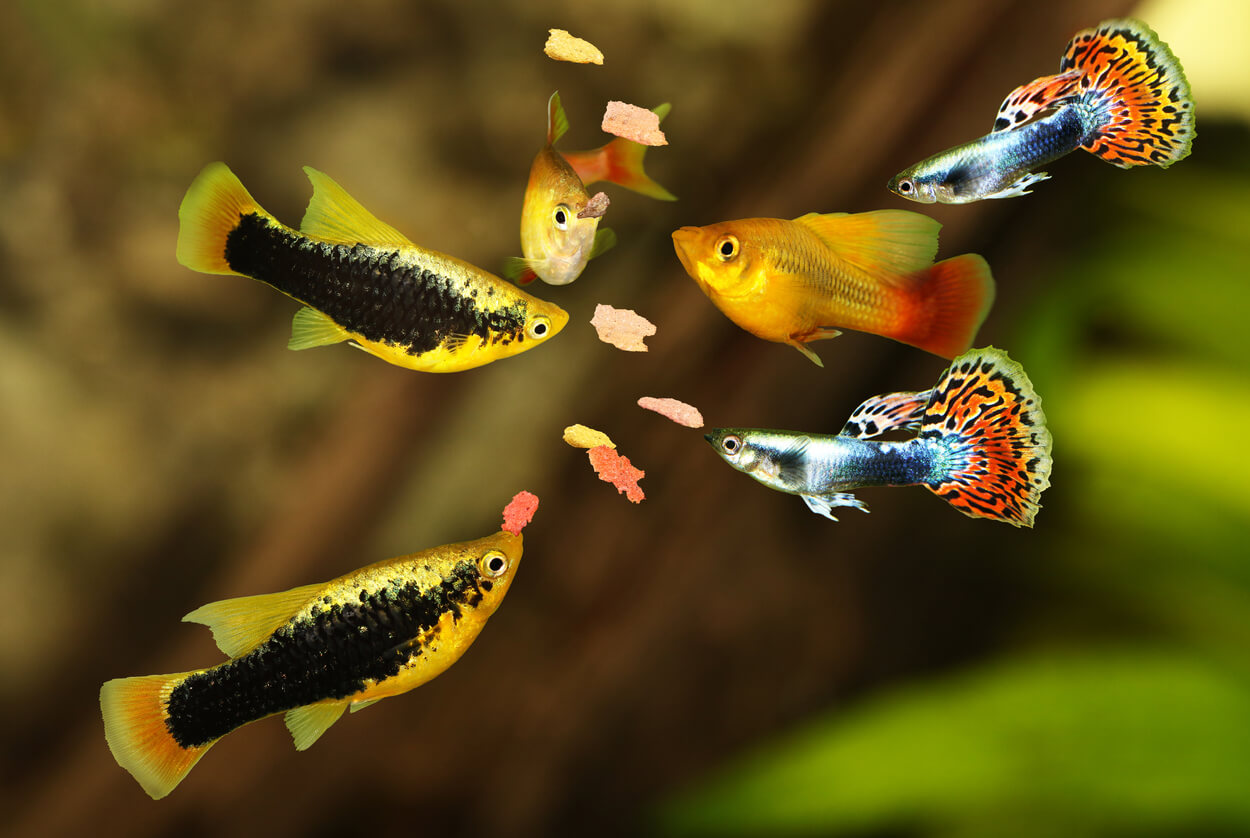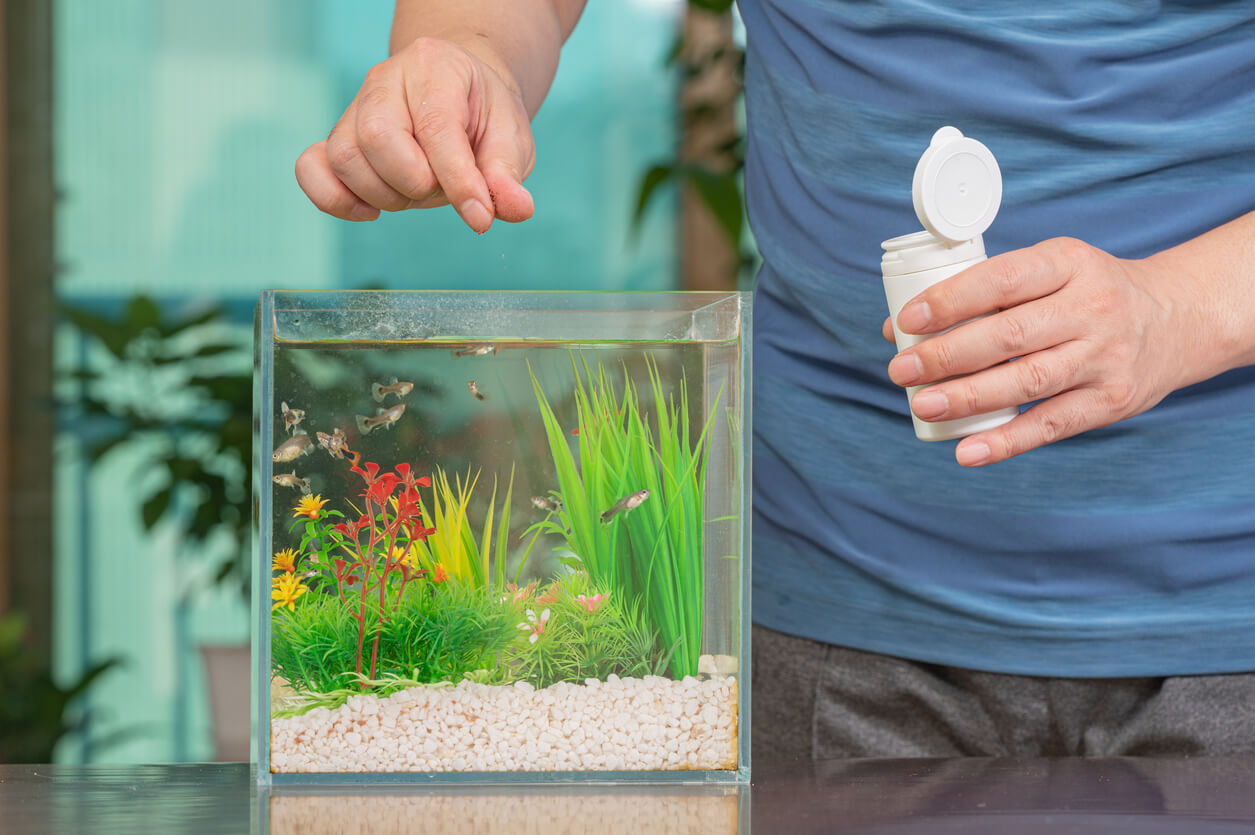How Many Times Do Fish Eat Per Day?
Knowing how many times fish eat per day is vital to respecting its specific nutritional needs. Find out the general criteria here!

If there’s one thing that’s as important, if not more important than water quality in maintaining an aquarium, it’s providing quality food for your fish. It’s not just a matter of knowing how many times fish eat per day, but knowing the species and its non-verbal language in order to identify when it’s hungry and to find the optimal feeding frequency.
You may be here because you want to adopt a fish and you want to give it the best life possible. Therefore, below you’ll find relevant information to manage its diet in the best way possible. Let’s get started!
The importance of studying the species
Feeding a fish is only one of the care factors that support the well-being of an animal. When you decide to bring a living being into your home, the most essential thing is to thoroughly study the species and its needs, as well as its behavior.
In particular, aquatic animals are quite distant – in biological terms – from us, so it’s more difficult for us to intuit their needs. Through a thorough study of the species, you’ll develop the ability to understand their behavior and the ability to detect any changes that pose a threat to their health.
[/atomik-read-too]
How do I know if my fish is hungry?

Learning to recognize hunger cues in these animals is vital to knowing how many times fish eat per day. Although, at first, they’re not very obvious to our species, you can base your knowledge on the following behaviors, which are specified by the Colombian Journal of Livestock Sciences:
- Swimming more actively and restlessly: Fish do this and approach the surface of the water more often when they’re hungry.
- Scavenging in the substrate: They move it around and peck at it to find food remains.
- Jumping on the surface of the water or stirring it: This is also a behavior related to foraging.
- Making slow movements or appearing disoriented: This is a more serious sign, indicating that the fish doesn’t have enough energy due to a lack of food.
- Attacking their tankmates: This manifestation could start to occur if they’re predatory fish.
It’s important to keep in mind that each fish species may show different behaviors related to hunger. In this regard, what’s indicated in previous paragraphs should be evaluated carefully. Make sure you know those specific to the species you care for.
How many times do fish eat per day?
There are several factors that determine the feeding frequency of a fish. Examples are species, age, and size. Also, within the specific dietary needs will be the individual variation of each fish.
A betta fish, for example, will need small amounts of food about two to three times a day, while guppies shouldn’t feed more than twice a day, as they’re much smaller.
Diet, of course, also plays a role, as herbivorous species may need a higher frequency of feeding than carnivorous species..
What happens if I give my fish too much food?

Realizing that a fish is hungry is important, but so is making sure not to overfeed your pets. In fact, this other extreme has negative consequences for their health:
- Decomposition of uneaten food remains in the water: Increased ammonia and nitrate, the occurrence of diseases, as well as the growth of unwanted algae in the water.
- Increased risk of obesity: Fish can also suffer from the consequences of excessive weight; these include prolapse, intestinal inflammation, or constipation.
- Filter clogging: Food debris left behind are pieces that can easily clog fish tank filters.
- Increased risk of parasites in the water: An example of this are planarians, flatworms that are seen more frequently in tanks where fish are overfed.
Homemade or commercial food? A question of balance and variety
Many fish keepers wonder whether it’s better to feed them homemade food or commercial diets. As usual, the answer depends on several factors ranging from the species of the animal to the lifestyle of the keeper. Let’s take a closer look!
Commercial fish food
The advantages of commercial food are clear: If you find a good brand, it’ll cover your fish’s needs completely and is much more convenient to administer. In addition, the packages themselves usually indicate how many times a fish eats per day.
Another positive aspect is that it’s easy to store. The packages don’t usually take up too much space in your cabinets, and its durability is extensive.
The problem with fish feed is that, in addition to informing you about the species you’re going to take care of, you’ll also have to read a multitude of labels to select the brand that best suits your needs. On the other hand, if you have a specimen with special nutritional needs, the generic formulation of this type of food may not be suitable.
You may be interested in: Choosing the Ideal Place for Your Fish Tank
Homemade food: Control and variety
Homemade fish food can be an appropriate choice if done correctly. Preparing homemade food allows for greater control over the ingredients and quality of the food offered to them. Therefore, a greater suitability to their specific needs.
Some people enjoy preparing a customized diet for their aquatic companions. It’s a way to bond with them and provide them with a feeding experience closer to what they would have in the wild. However, this option requires time and, sometimes, greater monetary investment.
On the other hand, calculating how many times a fish on a homemade diet eats will be a process of trial and error.
In this regard, it requires further study of the nutrition of the species being cared for, but it can be worthwhile if done well.
Feeding frequency dictated by nonverbal language
Caring for a fish is as big a responsibility as caring for a dog or a bird. While it’s true that their expressiveness is very different from that of our species, once you learn to read their language, it’s easy to attribute hunger, stress, or even happiness to them. So, when you find out how many times a fish eats a day, don’t forget the rest of the care.

